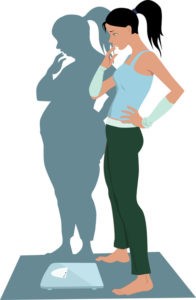Home » Student Portal » Mental Health » Eating Disorders
Eating Disorders
Eating disorders may cause severe disturbances to a person’s eating behaviours. Common eating disorders include anorexia nervosa, bulimia nervosa, and binge-eating disorder. Eating Disorders can be a way of coping with emotional distress, or can be a symptom of underlying issues (NIMH, 2016).
Often eating disorders are blamed on the pressure society puts on people to be thin. However, the evidence suggests it is more complex. Some biological factors combined with influential factors and experiences can build an unhealthy set of reasons that provoke the disorder, and other factors then contribute to the condition continuing (HSE, 2016).
How common are eating disorders
- 1 in 250 women experience eating disorders
- 1 in 2000 men experience eating disorders
- Women made up 87% of all hospital admissions who were affected by eating disorders in 2015 (Bodywhys, 2015)
- The condition commonly develops at approximately 16- 17 years of age
- Bulimia is five times more common than Anorexia Nervosa
People experiencing an eating disorder
- May have a high concern with body shape, weight, and an obsession with ood
- View being thin as a solution to all problems and fear weight gain
- Have low levels of self-esteem but this may not be obvious as those who have eating disorders may be high achievers
- View their own body as bigger than it actually is
- Find it hard to discuss their feelings
- Struggle to express their needs or may be isolated from others
- Experience mood swings
- See change as difficult and challenging

Risk factors for eating disorders
- Experiences of criticism for eating habits, body shape, or weight in the past.
- An obsession with being slim, in particular if the person has additional pressures to be slim such as job pressures in the case of models, athletes, or ballet dancers.
- Obsessive personality traits, Anxiety Disorder, or low self-esteem can be risk factors for Eating Disorders
- Past experiences of Sexual or Emotional Abuse
- Difficult relationships with those close to you such as family or friends
- Having a family history of Eating Disorders, Depression, or Substance Misuse (HSE, 2016)
Types of eating disorders
Anorexia Nervosa is an eating disorder characterised as the refusal to eat enough to maintain a healthy body weight.
Symptoms of Anorexia Nervosa include;
- Extremely low body weight
- Severe food restriction
- Relentless pursuit of thinness and unwillingness to maintain a healthy body weight
- Intense fear of gaining weight
- Distorted body image and self-esteem that is heavily influenced by perceptions
- Lack of menstruation among girls and women (NIMH, 2016)
Medical Complications that can develop;
- Damage to the structure and function of the heart
- Lethargy, sluggishness, or feeling tired all the time
- Infertility
- Multi-organ failure
- Drop in internal body temperature, causing a person to feel cold all the time
- Brain damage
- Mild anaemia
- Dry and yellowish skin
- Growth of fine hair all over the body (lanugo)
- Thinning of the bones (osteopenia or osteoporosis)
- Brittle hair and nails
- Low blood pressure, or slowed breathing and pulse
- Muscle wasting and weakness
- Severe constipation (NIMH, 2016)
Bulimia Nervosa involves eating unusually large amounts of food and feeling a lack of control during these episodes. Binge eating is followed by forced vomiting, or excessive use of laxatives, excessive fasting or excessive exercise or a combination of all these behaviours.
Bulimia nervosa is different to anorexia nervosa in that those with bulimia nervosa often keep a healthy body weight.
Similar to Anorexia Nervosa, individuals with Bulimia Nervorsa fear gaining weight, wish to lose weight and are consistently unhappy with their body shape.
Usually, bulimic activities are done in secret as the person may experience feelings of shame about what they do.
How often do these episodes happen?
The episodes of binge eating and purging can occur from several times per week to several times per day
Symptoms of Bulimia Nervosa;
- Inflamed sore throat for a prolonged period of time
- Swelling in salivary glands around neck and jaw areas
- Tooth decay and damaged enamel from acid re-flux
- Irritation of the intestines as a result of abuse of laxatives
- Dehydration from purging fluids
- An imbalance of electrolytes which can lead to heart attack and stroke
People who have a Binge Eating Disorder experience loss of control over their eating. Binge Eating is not like Bulimia Nervosa as it does not involve purging, fasting, or excessive exercise followed by periods of binge eating. Often it results in people with Binge Eating Disorders becoming overweight or obese.
Symptoms of Binge Eating Disorder;
- Eating unusually large amounts of food in one episode
- Eating when not hungry
- Eating quickly during a binge
- Eating beyond the level of being full
- Eating on your own due to being embarrassed
- Feeling stressed, guilty about eating
- Often dieting without achieving any weight loss
Where can I get support
If you feel that you may have an Eating Disorder, the Student Health team can provide you with the necessary advice and treatment to help in your recovery.
Student Counselling Service on:
- Email: studentcounsellor@nullitsligo.ie, or
- Phone: 071 930 5463
Student Health Service on:
- Email: studenthealthservices@nullitsligo.ie.
- Phone: 071 93 05205
Eating Disorder Therapist, Community Mental Health Team, Sligo
Tel: 071 915 5100
Bodywhys Helpline: 1890 200 444